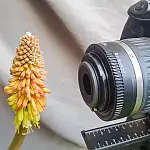How To Perform Lens Autofocus Microadjustment CalibrationImprove your photography and take more precise autofocus shots with our in-depth guide on autofocus microadjustment techniques.
If you're looking to get the most out of your photography, the autofocus microadjustment facility is a great tool to have in your arsenal. With the right calibration technique, you can vastly improve the accuracy and precision of your autofocus shots, resulting in clearer, sharper, more detailed images.
How Autofocus Works
DSLRs use two different types of autofocus microadjustment techniques that use two different AF systems for focusing:
When utilising the optical viewfinder, phase detection AF is active. Another AF sensor or focusing array is built underneath the mirror arrangement and is used by this focusing mechanism. As a result, if there is even a tiny misalignment between the focusing mechanisms, focus problems may develop. Although quick, this approach is not usually extremely precise.

When using the live view, contrast detection AF is active. The sensor's built-in focusing points are used by this system. This means that if images are in focus during live view, you will obtain results that are identical to what you see on the screen, however, this approach is slower than phase detection AF.
We won't go into detail about how the two ways vary right now. Because focus faults are visible when focusing by looking through the viewfinder, autofocus micro adjustments must only be made for the optical viewfinder.
What is Autofocus Microadjustment?
Autofocus micro adjustment is an advanced calibration technique that enables you to fine-tune the autofocus performance of your camera lens. It involves adjusting your camera or lens auto-focusing capabilities, ensuring that they are accurately focused on the subject you are shooting. By adjusting this setting, you can ensure that your autofocus shots are more precise and accurate.
It enables you to fine-tune your camera's focus systems for specific lens combinations, essentially calibrating the camera for a specific lens so that the focus is sharp.
Can All Cameras Use Autofocus Microadjustment?
This feature is only available on a small number of cameras. If your camera has a fixed lens then almost certainly not since this is a feature of digital SLR cameras with interchangeable lenses. The feature is more commonly found on mid-range "prosumer" to professional-level models. You can check the camera handbook or the manufacturer's website for your camera specifications and features. Look for AF adjustment, micro adjustment or lens calibration.
There are two levels of autofocus microadjustment, some models only offer an "All by same amount" option which adjusts all lenses by the same amount, whilst the "Adjust by lens'' option will read the lens serial number and store a micro adjustment value for each lens. This way you can calibrate all your lenses and when you swap them the camera automatically changes the AF micro-adjustment setting for that lens.
When Should You Perform Autofocus Microadjustment?
Be sure you have tried the following first before making any autofocus micro adjustments because if you don't, you risk affecting a lens that is operating properly and has no autofocus issues.
Before beginning to change the autofocus micro-adjustment, carefully read the following information:
- If you're just starting in photography, be sure to learn the basics, gain experience, and eventually, if you're certain that the camera or lens is to blame, look into making autofocus micro-adjustments.
- Verify that you are using the proper shutter speed and that the slow shutter speed is not the root of the blurry or out-of-focus problem.
- Always use the appropriate focusing modes for the situation and kind of shooting. Without it, you risk focusing incorrectly and attempting to micro-adjust as a result.
This is a simple test to determine if the camera and lenses you are using have any autofocus problems. Before beginning the entire set-up, you can run this as a quick test.
- Mount the camera on a sturdy tripod and turn off image stabilisation.
- Set the camera to live view and place the subject in the centre of the screen while positioning the camera. Put the AF point selection in the centre of the screen and set it to "Single point."
- Set the lens's aperture to the widest setting. Choose an ISO and shutter speed, and keep your subject in sharp focus.
- Once you have taken an exposure, switch to viewfinder shooting in live view and select "One shot" AF.
- Now halfway push the shutter button while watching the focus ring to see if it turns in either direction when focussing on your subject. Your focus ring is focused away from the desired location and needs to be micro-adjusted if it spins and moves to a different position to focus once more.
- Take an exposure using viewfinder shooting and compare the results at 100% zoom on a large screen. If there are differences then you need to be micro-adjusted.
Calibrate Your Lens and Camera with a Target Chart
The way to calibrate your autofocus settings is to use a target chart or any printed content from newspapers or magazines with high-contrast text (ideally large black and white text). These charts will help you fine-tune the accuracy of your lens and camera combination.

Camera Settings for Autofocus Microadjustment
Set the aperture priority (Av) mode on your camera. Manual mode is an alternative. The aperture value should be set to the largest opening. For instance, if your lens's widest aperture is f/2.8, set it to f/2.8. This way, a very tiny focus shift can be seen. You can slightly narrow the aperture down to, say, f/4 and then at f/5.6 and repeat the process for the adjustment test and compare the results if your lens is not the sharpest at its widest aperture value.
Set the ISO dial to the setting you typically use for the kind of photography you perform most frequently. Set the shutter speed after checking the light metre. Set the focal point to "One shot", drive mode to single shot, and the white balance to the setting you often use most frequently.
Steps for Autofocus Microadjustment
You must follow these steps and pay attention to the details. A slight knock of the tripod will invalidate any results so far. It's handy to note down what each exposure was for so when you transfer to a computer you can refer to each photo's notes to see the settings used.
Here are the actions you must take before beginning the precise AF micro adjustment procedure.
- Do the test outside if you are a photographer who primarily takes pictures outside, or inside if you have an inside studio where you do the majority of your photo shoots. To prevent reflections, make sure the target or subject is brightly lighted from a direction that avoids reflections or shadows.
- For your lens to focus, you must pick a rough shooting distance outside of the minimum focusing distance. Canon advises staying between 25 and 50 times the focal length of the lens if you are unsure of the distance between your camera and the subject you frequently photograph. When you move too far away from your subject, the depth of field increases, making it more challenging for you to confirm that your focus is accurate.
- Your test chart or printed paper needs to be mounted on a perfectly flat surface so it can be kept perpendicular to the lens. You could mount it in a wooden frame or flat on a vertical wall.
- Turn off image stabilisation on both the camera and the lens, then mount them both on a tripod. Set the camera's height such that the subject and the camera are parallel to one another and at right angles (the lens should be perpendicular to the subject). This is because you must aim your shot at a 90-degree angle, flat on the subject. Thus, using a tripod is advised rather than doing it by hand.
- To prevent camera wobble, use a shutter release cable with the mirror lockup option. Use the camera's timer delay function if you don't have a shutter release.
- Take a series of photos of your test chart, then check the focus and sharpness on a big screen at 100%.
If the test photos show to be out of focus then the micro adjustment needs to be changed. If you have a professional test chart you will be able to see on the gauge if you need to adjust the front or back, but if you just have a printed chart or magazine page then you will have to guess which way to go.
Within the camera settings (on Canon its Menu > Custom Functions > Autofocus) what I do is take a series of photos from -5 to +5 around the current autofocus microadjustment setting and see which photo produces the sharpest result. I have also in the past taken a series of photos from -20 to +20 at each step and compared them at 100% zoom on a high-definition display to see where the exact sharpest point is.
Understanding Correction Values When Setting the Autofocus Microadjustment
The value you assign will depend on the focus accuracy of your photos. A positive number will mean the camera focuses slightly in front of the specified point, while a negative number means that it focuses behind the selected point. The exact amount can vary, but some autofocus microadjustment lenses may offer increments as small as 1/10th of a millimetre and as high as 1 millimetre. Be cautious when making adjustments at this level and don't go too far in one direction or the other.
















